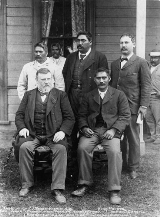
Mahuta Tawhiao
Encyclopedia
| Reign | 26 August 1894 – 9 November 1912 |
| Coronation | 14 September 1894 |
| Spouse | Te Marae Te Kerei |
| Predecessor | Matutaera Tāwhiao Tawhiao Tāwhiao I, Māori King , was leader of the Waikato tribes, the second Māori King and a religious visionary. He was a member of the Ngāti Mahuta iwi of Waikato.... |
| Successor | Te Rata Te Rata Te Rata Mahuta was born sometime between 1877 and 1880 and was the eldest son of the third Māori King, Mahuta and Te Marae, daughter of the fighting Chief Amukete Te Kerei who was killed in battle at Rangiriri in November 1863. He married Te Uranga of Ngati Koroki... |
| Father | Matutaera Tāwhiao |
| Mother | Hera Ngapora |
| Born | C 1854/1855 |
| Died | 9 November 1912 |
Mahuta Tāwhiao I, Māori King (1855?–1912) was the third Māori King
Maori King Movement
The Māori King Movement or Kīngitanga is a movement that arose among some of the Māori tribes of New Zealand in the central North Island ,in the 1850s, to establish a role similar in status to that of the monarch of the colonising people, the British, as a way of halting the alienation of Māori land...
, reigning from 1894 to 1912, and member of the New Zealand Legislative Council
New Zealand Legislative Council
The Legislative Council of New Zealand was the upper house of the New Zealand Parliament from 1853 until 1951. Unlike the lower house, the New Zealand House of Representatives, the Legislative Council was appointed.-Role:...
from 1903 to 1910.
Early life
Born around 1854/5 at Whatiwhatihoe in the WaikatoWaikato
The Waikato Region is a local government region of the upper North Island of New Zealand. It covers the Waikato, Hauraki, Coromandel Peninsula, the northern King Country, much of the Taupo District, and parts of Rotorua District...
, Mahuta was the second son of King Tāwhiao
Tawhiao
Tāwhiao I, Māori King , was leader of the Waikato tribes, the second Māori King and a religious visionary. He was a member of the Ngāti Mahuta iwi of Waikato....
and his first wife Hera. During his childhood in the 1860s New Zealand
New Zealand
New Zealand is an island country in the south-western Pacific Ocean comprising two main landmasses and numerous smaller islands. The country is situated some east of Australia across the Tasman Sea, and roughly south of the Pacific island nations of New Caledonia, Fiji, and Tonga...
was embroiled in war and in his adolescence his family took refuge in the isolated King Country
King Country
The King Country is a region of the western North Island of New Zealand. It extends approximately from the Kawhia Harbour and the town of Otorohanga in the north to the upper reaches of the Whanganui River in the south, and from the Hauhungaroa and Rangitoto Ranges in the east to near the Tasman...
, so Mahuta received very little European education, spoke little English and was very much a traditionalist.
During his twenties, Mahuta married Te Marae, with whom he had five sons: Te Rata
Te Rata
Te Rata Mahuta was born sometime between 1877 and 1880 and was the eldest son of the third Māori King, Mahuta and Te Marae, daughter of the fighting Chief Amukete Te Kerei who was killed in battle at Rangiriri in November 1863. He married Te Uranga of Ngati Koroki...
(who succeeded him as king), Taipu, Tumate, Tonga and Te Rauangaanga.
Reign as king
When his father died in August 1894, Mahuta was made Māori King, taking the throne on 15 September of that year.Under Mahuta's rule, the King Movement
Maori King Movement
The Māori King Movement or Kīngitanga is a movement that arose among some of the Māori tribes of New Zealand in the central North Island ,in the 1850s, to establish a role similar in status to that of the monarch of the colonising people, the British, as a way of halting the alienation of Māori land...
's first courts were created, with judges, clerks and registrars. However, his nation weakened greatly by the turn of the century. The Māori people had very little land, and population crises and poverty ravaged them. Through a series of deals with colonial authorities, including joining the Legislative Council
New Zealand Legislative Council
The Legislative Council of New Zealand was the upper house of the New Zealand Parliament from 1853 until 1951. Unlike the lower house, the New Zealand House of Representatives, the Legislative Council was appointed.-Role:...
, Mahuta regained a little influence for his people, though the last years of his life were fraught with personal troubles.
He died at Waahi on 9 November 1912 and was buried on Taupiri Mountain
Mount Taupiri
Mount Taupiri is a sacred mountain and burial place for the Tainui Māori People based in the Waikato in the town of Taupiri.Taupiri is a small township on State Highway 1 and the Waikato River north of the town of Ngaruawahia and south of Huntly in the Waikato Region...
.

